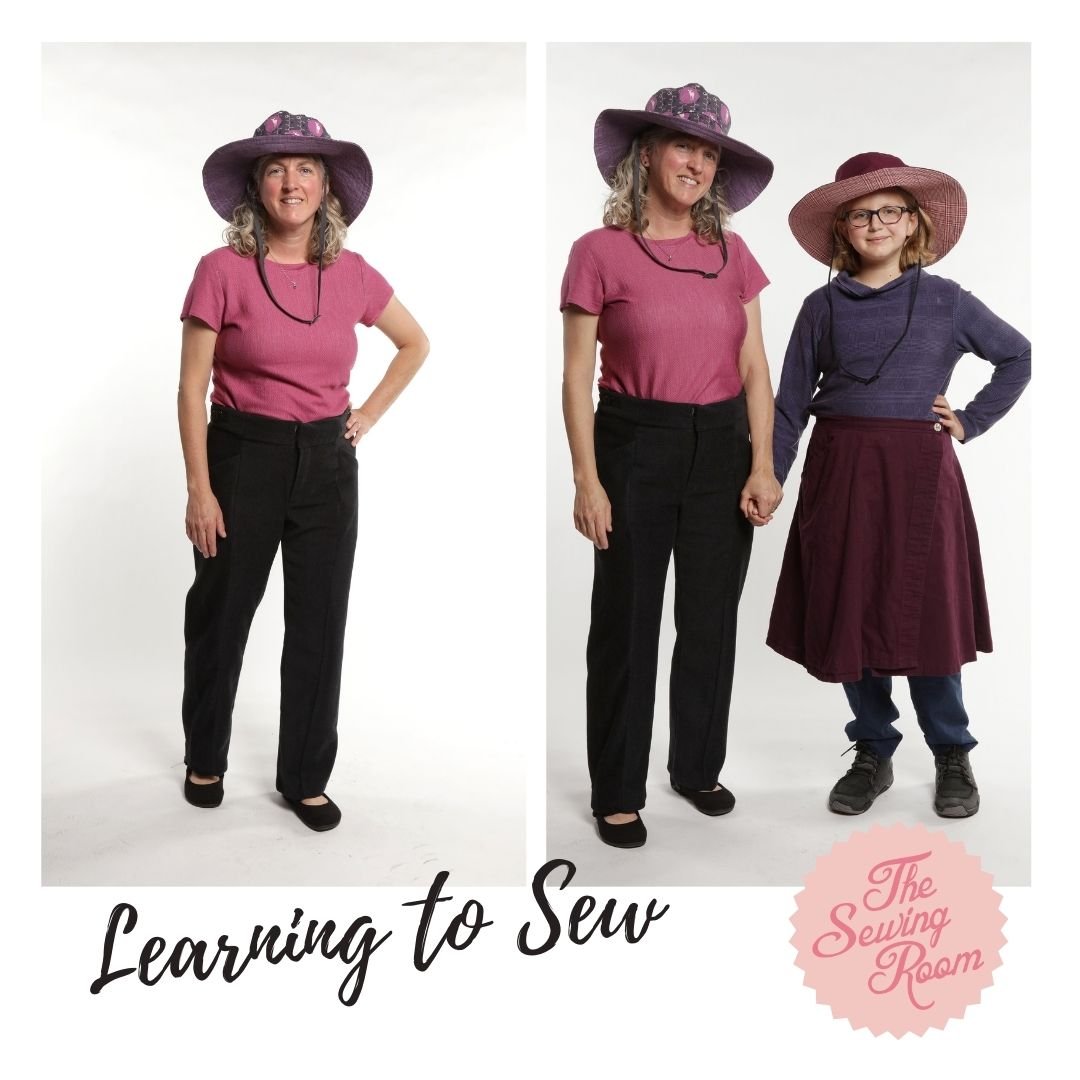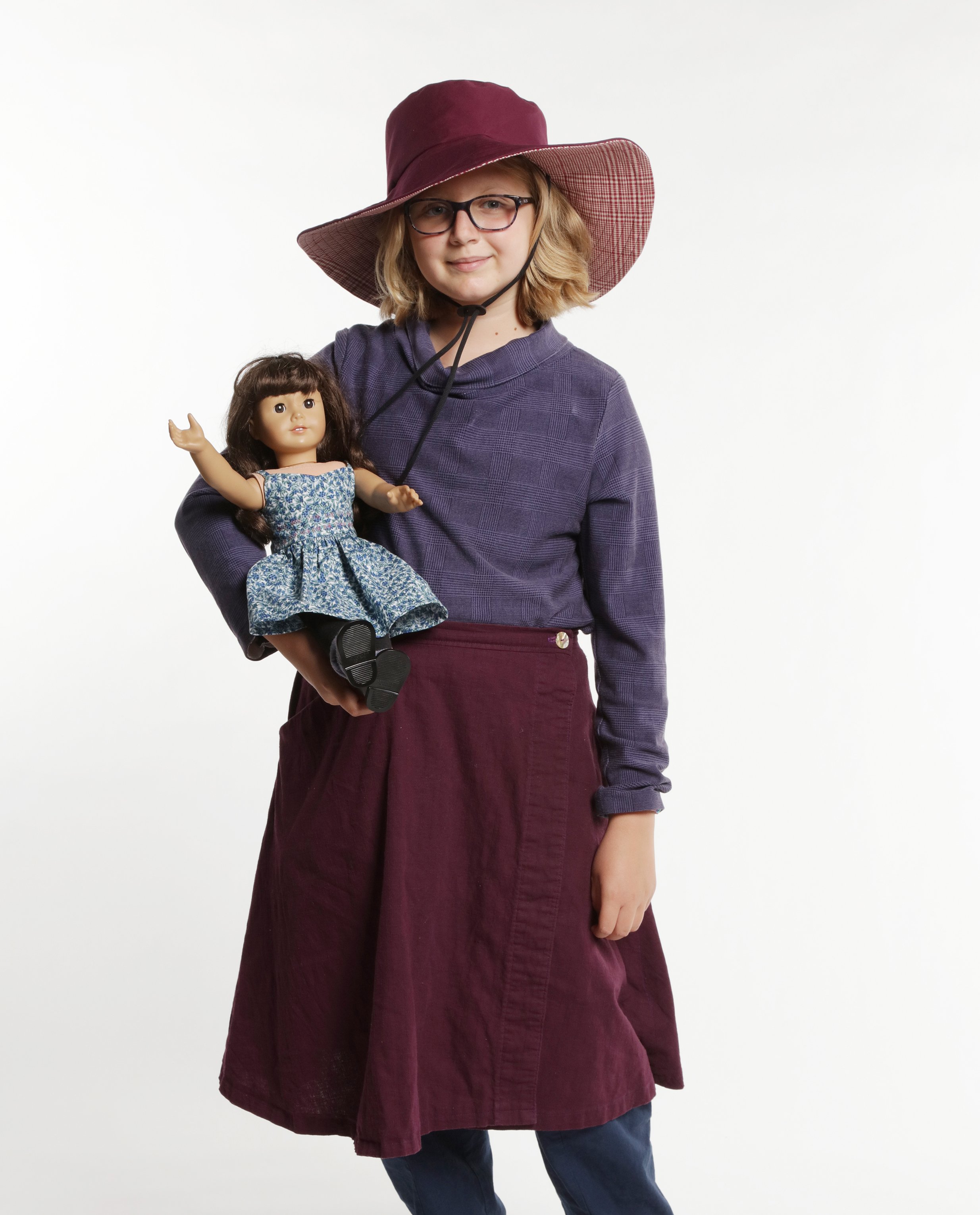by Student & Guest Blogger - Diane E. Tschirgi
Sewist, Sewer, Someone Cool Enough To Sew Own Clothes (SECSOC)
Whatever it’s called, my question was, “How do I become one?” Sure, I took Home Ec (now Life Skills) and learned to make a draft dodging sock stuffed with rice. I distinctly remember when it developed a hole (along my stitching line), and the rice went everywhere.
I have wrangled with tissue paper patterns that, once opened, can never be returned to their original package. It is alarming how quickly those mysteriously marked directives take over one’s dining room table. You might think I’m exaggerating and take my musings with a grain of salt. That is, if you can find the grain.
Grain? That’s the direction of fabric. To find it, you also need to know selvage. (And lengthwise, crosswise, and bias. Except if its knit. Knits are just the direction that the fabric is stretchiest.) But for everything else, which means woven fabric, you must match the long straight arrow on the pattern to the actual lay of the fabric land. There goes your living room floor space.
Unwilling to be defeated by fifth-grade geometry concepts, I folded a two-yard bolt of cloth with its selvedge (the end that’s meant to be cut and discarded) matching. Then, with the flourish of a magician, flung and watched it float smoothly down to settle onto the floor, the selvedge nice and straight. Straight! That is also what Lengthwise is called. And it is what needed finding.
The straight grain runs parallel to the selvedge. The selvedge often has factory marking s on it, but if that’s not the case, it’s still detectable as the least stretchy way the fabric pulls. Pull perpendicular (Crosswise) and you’ll get more stretch. Pull diagonal (Bias) and it will be the stretchiest. Once you’re sure of the direction, pin the pattern arrow to the fabric, running along the grain. Ah, I can feel the wind in my hair already.
Before attempting my first sewing project, I wondered, What could a middle-aged mom do to learn something it felt like she should already know? Sign her ten-year-old daughter up for lessons, of course! And then eavesdrop and ask endless questions.
That worked for a while. Through her, I learned to identify and mark little circles on the correct pattern size. The importance of using paper scissors for the pattern, and fabric scissors for the fabric. To place the pins inside the pattern facing toward the edges, so when you get to that spot with the scissors you can easily slip the pin backward without disturbing the pattern piece. Resting the bottom of the scissors on the tabletop and moving your body (not the pattern) around the table, for a smoother cut.
But tween reconnaissance has its limits, and it became obvious, as I surveyed my living room floor with its impaled cloth monster that vaguely resemble human body parts, that I needed more instruction.
I picked up the phone and scheduled my own lessons at The Sewing Room Alameda.
I don’t want to be rude to the person teaching me a life skill, buuuuut, I’m new at this, and Jennifer Serr is not. The Sewing Room Alameda proprietor is a true expert, unruffled by any inquiry, and she possesses mad sewing skills. Before she set up shop and began teaching Bay Area kiddos and adultos the art of making, she kept The Gap in perfect patterns, making needed corrections herself. Think about that – she dressed an entire generation of young people – and now is teaching us to do the same.
I, on the other hand, was stumped at the very first word, “Self.” The exact writing was, “Cut 1 Self.” I was pretty sure it wasn’t referring to self-harm nor a self-improvement resolution. Turns out, “Cut 1 Self” is also stated as “Cut 1 Main” which is Sewist Speak for cut one pattern piece out of the “main” fabric you want to make a garment from. Self=Main=First direction in a pattern. Got it.
The next confounding term was Right Side/Wrong Side.
It’s not a philosophical discussion about good and evil. It refers to the Main (Self) fabric having a Right Side, which is the side the world will see and is abbreviated RS. And a wrong side (WS), which is what the wearer’s body will see, which, perhaps should be a philosophical discussion. All fabrics have both, but it’s not always easy to tell which is which. It is, however, imperative to determine which is which before pinning the pattern to the fabric and making the first cut.
If the right side is not obvious (like very bright and colorful), there are other ways to tell. Studying the degree of fuzziness (there’s less on the RS; or the tiny holes along the selvage (where the factory pinned the material down) - the neater those holes, the righter the side. In my opinion, the best way is to go and ask Jennifer and she’ll point you in the Right Direction.
After some weeks of back and forth from my living room to the Sewing Room Alameda, where I got a myriad of questions answered, I now know the difference between a knit and a woven fabric. (Woven has grain, knit does not.) I know to wash the fabric and iron it before cutting. I can identify the grain on woven cloth, at least if there is an obvious selvedge. I can pin pattern pieces and cut with the right tool. I’m feeling pretty good about mySelf. So, imagine my surprise when the first direction on a princess seam vest pattern was to “finish seams.” Finish? But, I haven’t even gotten started!
“Finish,” in Sew Speak, means to keep an edge from unraveling. And the directions to do so can come at unexpected times, such as before the seams are sewn together.
I zigzagged along the edges of each piece. Another option would have been to use a Serger machine, or pinking shears. But, while I had learned a new term that came with at least three techniques, I was far from finished. The pieces needed to go together in a curvy, princessy way. My daughter had made this pattern months earlier, in her classes, and had worn her vest many times.
Use a lot of pins, and, Go slow
I asked her to recall more tips and techniques, and got, “Use a lot of pins,” and, “Go slow.” Not a lot to go on, but I tried it, and sure enough, those two tips were just what was needed. Soon, I had a matching vest, except that I didn’t size it properly and so, really, she got a second vest.
Eventually, she got more pieces from my trial and error, more accurately, toile’ing and error. A toile is a fancy Sewer’s word for practice. And what I’ve learned the most from all this practice is patience. A terrific life skill!
Now, when my daughter chooses the (fourth) toile I made before perfecting a pair of pants with the most amazing side pockets, over everything else in her wardrobe, I am immensely happy. When my son asks for another merino wool shirt, I glow. When I put on my own merino wool shirt and pants and examine the seams and see how strong and finished they look, I have a little extra bounce in my stride when I pass by the department store on my way to The Sewing Room Alameda. I think, maybe next time. I have a new pattern to pin.
Diane is a writer, and attempting to be a sewist. Like many creatives, she can get mixed and might do things in an odd order, like earn her Associate's Degree in English after a Master's Degree. Focusing solely on literature and creative writing was definitely more fun than History or International Relations Theory! Also like some creatives, she finds it difficult to pin down a specialty. So, she works best in argumentative essays, research on historical and contemporary issues, and drafting up short stories. If you could use the help of a writer, please contact Diane at greentreeink@gmail.com.





